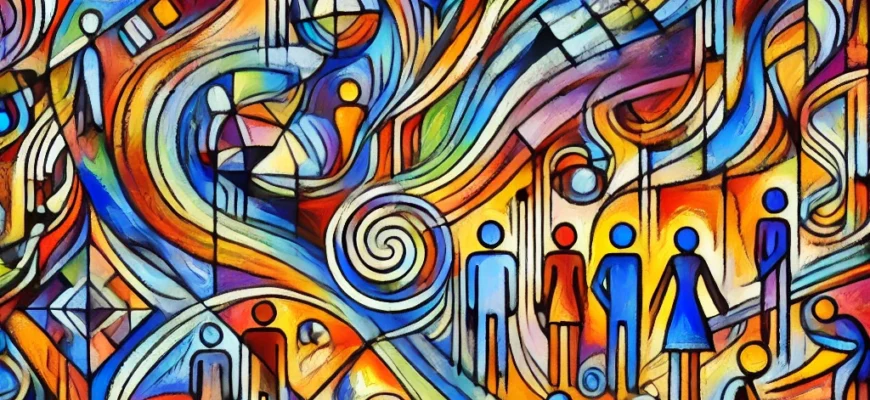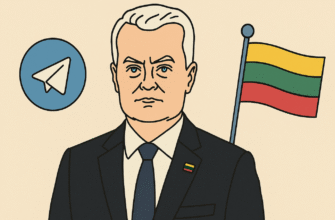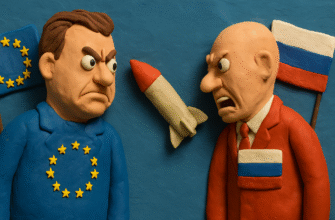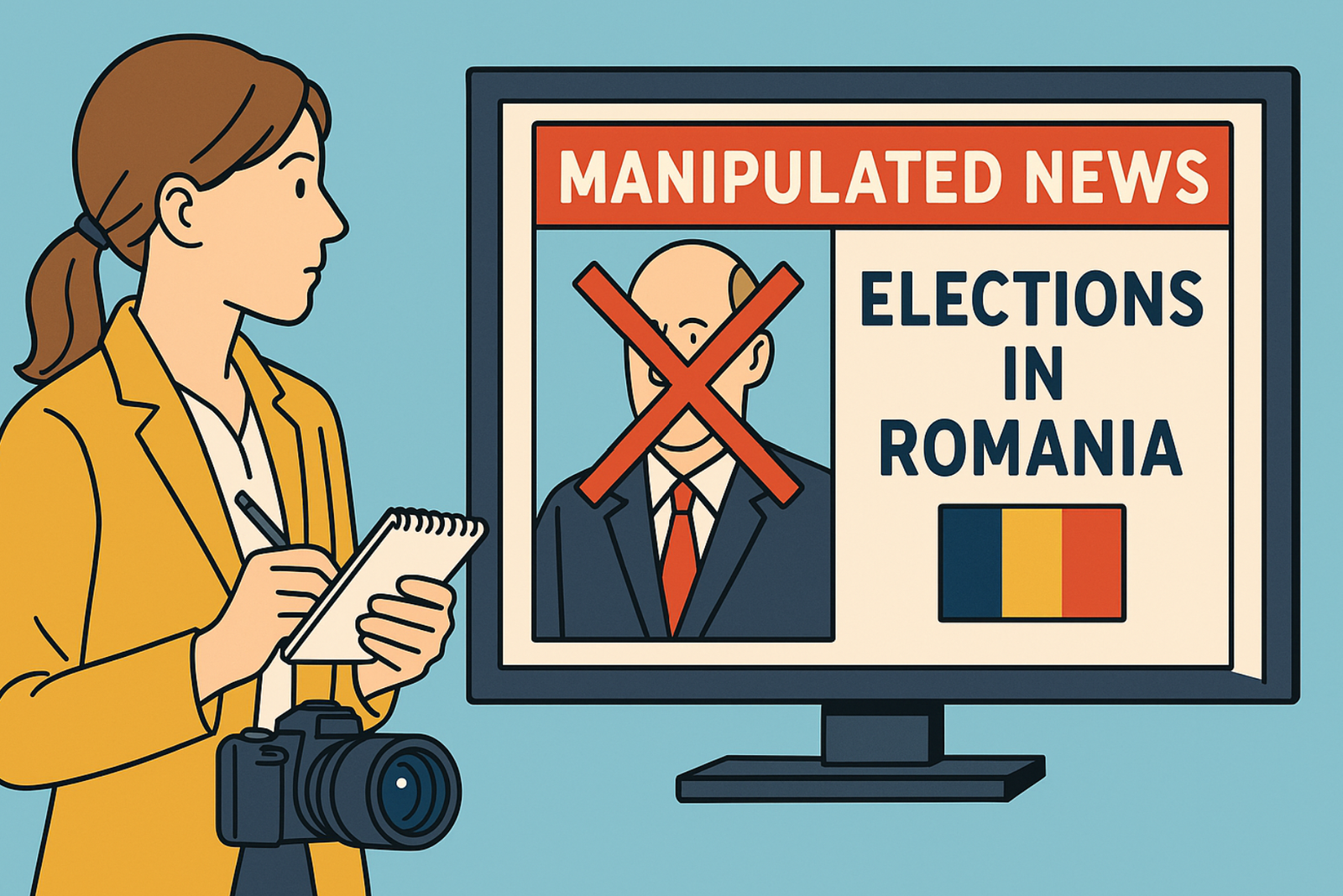This is our regular publication dedicated to the topic of disinformation about civil society in the Belarusian information space.
Methodology The dataset was collected using the Oxylabs Web Scraper API tool. In September, 1,298 messages were collected from 77 sources, involving 757 authors.

The main work accompanying the term “civil society” revolved around, understandably, the presidential election campaign, covering events such as the socio-political forum “Belarus Adzіnaya,” the Unity Day celebration (September 17), and the “Unity Marathon.”
For example, one of the current regime’s main ideologists, Vadim Gigin, explained the mechanics of the “Unity Marathon” campaign, using their favorite neologism subjects of civil society:
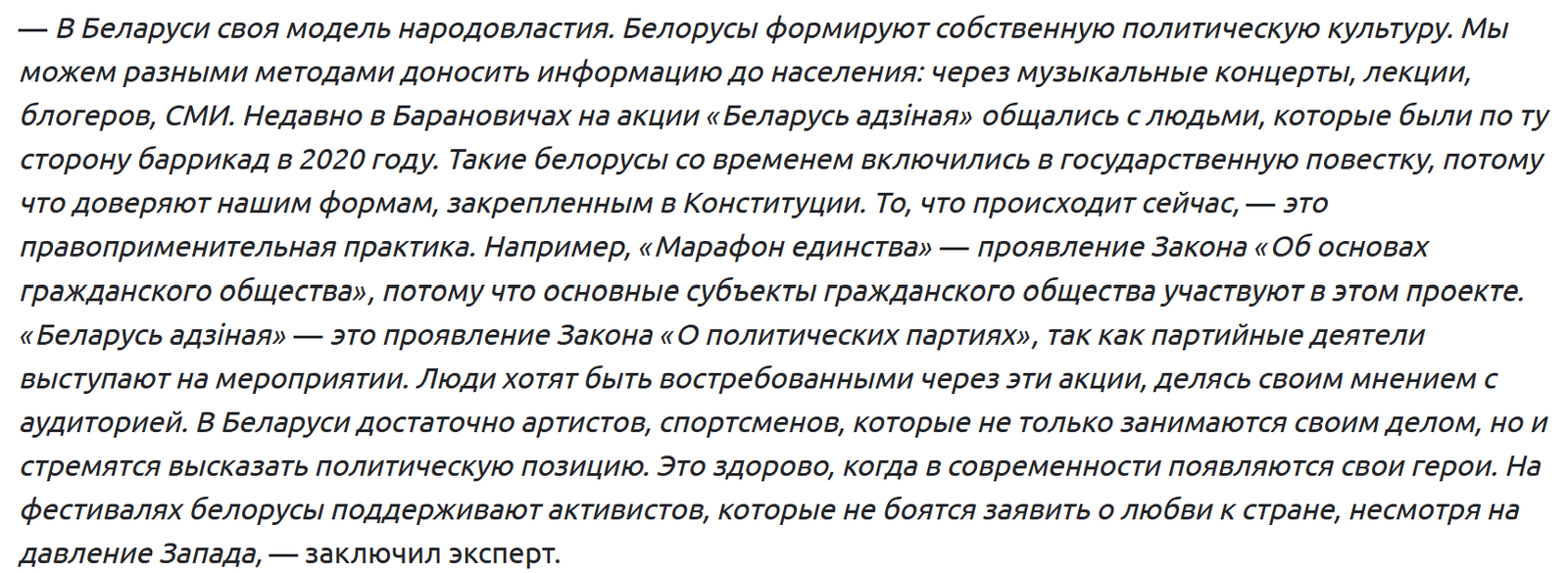
Let’s examine the quote for possible disinformation narratives. Key points of the analysis:
- “Belarus has its own model of popular governance”:
- This statement forms the idea that Belarus has a unique governance model that differs from Western democratic standards. This may be an attempt to legitimize the existing political system and dismiss any external assessments as inappropriate or hostile.
- “Belarusians are forming their own political culture”:
- This thesis emphasizes national identity and can be used to justify the lack of democratic freedoms or the suppression of protests, presented as “foreign” elements that do not fit into this “political culture.”
- “These Belarusians eventually integrated into the state agenda because they trust our forms enshrined in the Constitution”:
- The claim of “integration” of protesters into the state agenda hints at successful “reeducation” while ignoring the potential pressure or coercion by the authorities.
- “This is law enforcement practice” and “manifestation of the Law”:
- The use of legal terminology to legitimize certain events creates the impression of legality and order, which may be an attempt to conceal real human rights violations.
- “People want to be needed through these actions”:
- This statement tries to show that participation in state actions is voluntary and natural, concealing potential coercion or restriction of alternatives.
- “They support activists who are not afraid to declare their love for the country, despite Western pressure”:
- This forms a narrative of resisting “Western pressure,” which is a typical rhetoric used to create the image of an external enemy and justify domestic restrictions. The emphasis is on patriotism and supporting “their heroes” to give participants in state actions a positive image and discredit critics.
- The text contains several typical disinformation narratives: justification of state policy through concepts of national identity and uniqueness; attempts to legitimize ongoing actions using laws and the notion of “law enforcement practice”; creation of the image of an external enemy (the West) and emphasis on patriotism.
- There is also an attempt to present state events as voluntary and widely supported, which may distort reality.
Another author of regular disinformation publications, Dmitry Kryat, lays the foundation for the “Unity Marathon”: 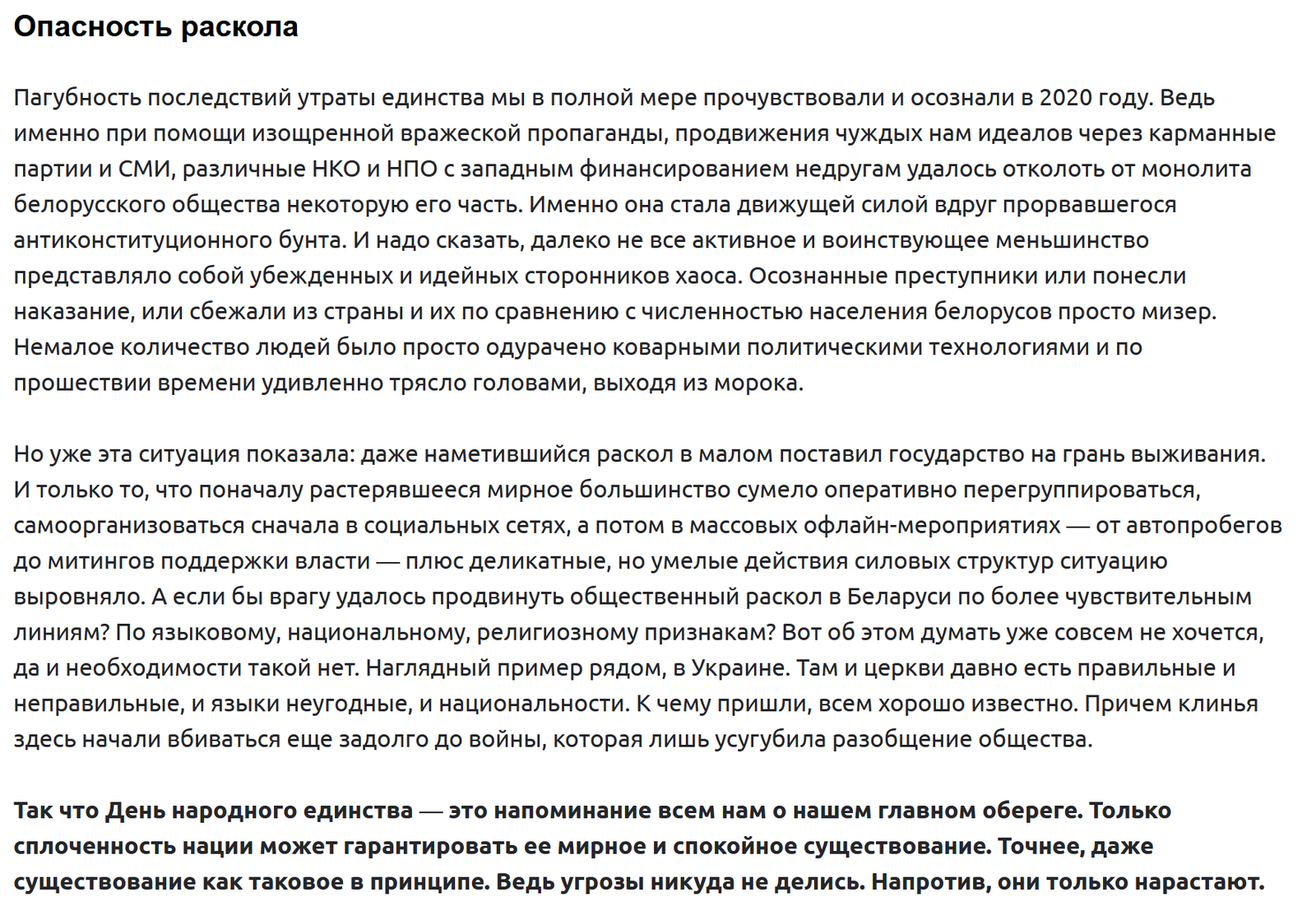
In this paragraph, several disinformation narratives can be identified, aimed at forming a specific perception of the events of 2020 in Belarus and justifying state actions. Key points of the analysis:
- “The pernicious consequences of losing unity in 2020”:
- The introduction of the term “loss of unity” and the statement about negative consequences imply that the 2020 protests were a threat to national unity and stability, thereby denying any attempts by society to express dissatisfaction as legitimate.
- “Sophisticated enemy propaganda, promotion of foreign ideals through pocket parties and media”:
- This is a classic disinformation tactic—creating the image of an “external enemy.” The claim of “enemy propaganda” and “foreign ideals” implies that the protests were exclusively influenced from outside rather than stemming from internal discontent. It also discredits opposition parties and independent media by asserting that they are controlled by foreign powers.
- “NGOs with Western funding”:
- This statement is aimed at fostering suspicion towards non-governmental organizations and discrediting them. It reinforces the narrative of “foreign interference” and portrays civil society as an agent of foreign interests.
- “Anti-constitutional revolt”:
- The protests are portrayed as a “revolt,” implying illegal actions rather than peaceful protests against injustice. This helps justify the repressive measures taken by the state.
- “Conscious criminals” and “deceived people”:
- Dividing protesters into “conscious criminals” and “deceived people” suggests that the protests were neither justified nor reasonable. Such characterization denies protesters the right to have an opinion and justifies the violent measures taken against them.
- “The initially confused peaceful majority managed to self-organize”:
- This claim implies that the majority of the population supported the government, and the protests were the work of a small minority. It describes “peaceful car rallies and rallies in support of the government,” creating the impression of massive support for the regime while ignoring the widespread protests at the time.
- “Delicate but skillful actions of law enforcement agencies”:
- Describing the actions of law enforcement as “delicate” and “skillful” distorts the reality of the violence and repression used against protesters. It aims to justify harsh actions and create a positive image of law enforcement agencies.
- “A vivid example nearby, in Ukraine”:
- Referencing Ukraine as an example to illustrate “societal division” aims to scare the population with the potential consequences of protests and change. It creates the narrative that any attempt at democratic reform leads to chaos and war.
The text actively uses disinformation narratives aimed at creating the image of an external enemy (the West), discrediting protesters, and justifying the state’s repressive actions. The protests are portrayed as illegal and instigated from outside, while any actions by the authorities are described as legal, delicate, and aimed at restoring order. The reference to Ukraine is used as a “scare tactic” to suppress any opposition sentiments in society.
Here is how offline events for this campaign looked like. For example, the socio-political forum “Belarus Adzіnaya” in Mogilev. The topic was held on the eve of Unity Day, titled “A Peaceful Country: Origins and Prospects of the Belarusian Development Model.” Speakers and their positioning included historian Vadim Gigin, journalists Grigory Azarenok and Vadim Shepet, and analyst Alexei Avdonin. Various topics were considered, ranging from historical retrospectives to future forecasts, such as protecting national interests, preliminary results of political construction (including the role of the All-Belarusian People’s Assembly and political parties), and the new format of civil society development.
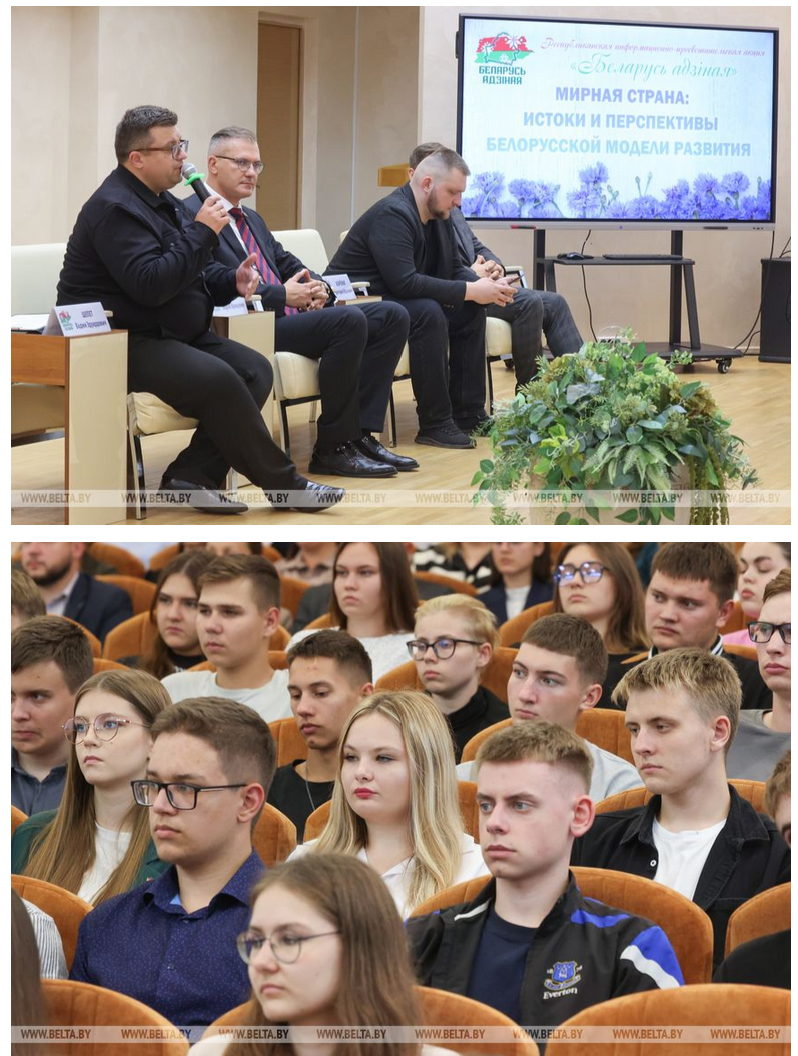
In the publication, several propaganda narratives can be identified, aimed at forming a loyal attitude toward the existing government and affirming ideals of unity and stability.
Key points of the analysis:
- Emphasis on unity and stability:
- The idea of national unity and the importance of preserving peace and stability is repeatedly emphasized in the text. Statements such as “Unity Day” and “we are united, and we have something to cherish” create an image of a stable, cohesive nation. This is done to discredit any opposition forces that may be presented as a threat to unity.
- Support for the president and the state:
- The mention of “the President’s trust in the youth” and “the significant contribution of the state” aims to create a sense of loyalty to the president and the government. The idea that young people should be grateful for the investment in their future forms a narrative of interdependence between the state and the people, where the state plays the role of a “guardian.”
- The image of “truthful information” and the discrediting of alternative opinions:
- Student Anastasia emphasizes that at such forums, “youth can learn firsthand what to believe.” This creates a narrative that state information sources are the only trustworthy ones, while alternative sources may be false or harmful. This suppresses critical thinking and fosters trust exclusively in state information.
- Symbolism and patriotism:
- Emphasis is placed on such holidays as Unity Day, Victory Day, and Independence Day, which are described as “important for our country.” Their symbolism is highlighted, which strengthens patriotic sentiments and creates a sense of pride in the country. This is done to strengthen the national identity associated with the current political regime.
- Active participation of youth in supporting the state:
- It is mentioned several times that young people actively participate in events and support the state. This creates an image of patriotic and compliant youth who share the values of the government and strive to support it. It also indirectly discredits young people who oppose the regime, portraying them as marginal or as those who do not fit into the collective image of a “good citizen.”
- Historical achievements under Lukashenko’s leadership:
- Mention of the “30 years of presidency” and “a unique achievement in our history,” concerning the preservation of peace in Belarus, creates a narrative that the current regime is responsible for a long period of peace and stability. This helps to strengthen the legitimacy of the government and justify its continuation.
- Demonstration of dialogue and openness:
- The importance of exchanging opinions and feedback is emphasized, which supposedly indicates the government’s openness to dialogue. However, this may serve to create the appearance of citizen involvement in political processes and implies that citizens can influence state decisions, although the real degree of influence may be very limited.
Conclusions:
The text actively uses propaganda techniques aimed at forming a positive perception of the current regime, patriotism, and confidence in the correctness of the government’s course. Propaganda narratives include an emphasis on unity and stability, support for the president, the creation of a positive image of state information, emphasis on patriotism, and active participation of young people in supporting the state. All of this is aimed at strengthening the legitimacy of the regime and forming loyalty among citizens.
All three texts contain pronounced disinformation and propaganda narratives aimed at legitimizing the existing regime, discrediting opposition forces, and forming a loyal attitude towards the authorities. The images of an “external enemy,” ideas of national identity, patriotism, and stability are used to justify repressive measures and suppress critical perception of events. Emphasis is placed on the importance of unity, support for state policy, and the assertion that official sources are the only trustworthy ones. All of this serves to manipulate public opinion and strengthen the power in the country.

